Many people hire a trainer to avoid making mistakes which can lead to injury. Call it what you want – exercise form, correcting mistakes, cueing, etc. Form cues are an essential component of personal training.
Ensuring a client can execute a specific movement with correct body mechanics is a necessity for safety when exercising.
Poor form means an increased risk of injury which could ultimately derail a client’s progress – if not reverse it entirely.
These 12 exercises present challenges for many clients. Here’s how you can help them overcome the struggle.
12. Squat
Red flags:
· Pressing through the toes on the upward motion
· Knees bowing out (varus) or caving in (valgus)
Things to try:
Before advancing a client to a traditional back squat or dumbbell squat, work on body weight squats using a resistance band. You can cue the client to press out slightly against the band to keep the knees in alignment and avoid varus or valgus movements.
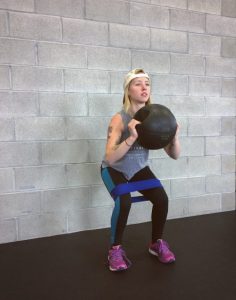
The knees should track over the second toe, but not extend excessively beyond the toes. Instruct the client to shoot energy through the heels rather than the toes.
Learn more about squat corrections in this article.
____________________
11. Lunge
Red flag:
· Rounding the shoulders and upper back
Things to try:
The torso should lean only slightly forward (rather than keeping the back completely and rigidly straight up and down). If the back remains rigid, this can increase the arching of the low-back.
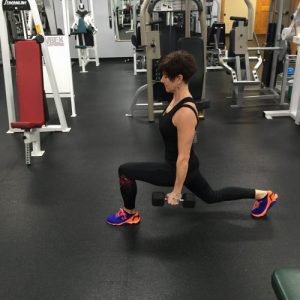
Arching of the back will be exaggerated if a client has tight hip flexors as this would cause the pelvis to move anteriorly.
The same rule applies here as it does to the squat – knees should track over of the second toe. Instruct the client to push through the heel of the lead foot so that the glute is activated on the upward motion.
Fortunately, there are many ways to modify a lunge.
________________________
10. Bench Press
Red flag:
· Arching the back
· Bouncing the bar off the chest
Things to try:
There are multiple points of contact the client’s body should make with the bench: the head, shoulders, torso, glutes, and feet (if the client is unable to keep his or her feet flat on the floor, instruct him or her to place their feet on the bench).
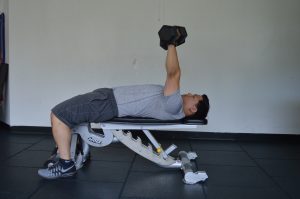
Ask the client to assume a supine position on the bench and evaluate these points of contact. Start with a lower resistance to teach proper mechanics.
If the back arches or the bar bounces off the chest, the weight is not appropriate. The weight should be moved through a full range of motion without momentum.
___________________________
9. Biceps Curl
Red flag:
· Elbows do not remain next to the body (flaring out)
· Arching the back on the upward motion
Things to try:
Place a rolled towel between the client’s arm and torso. Instruct the client to keep the towel held tightly in place as he or she performs a curl.

Start with a lighter weight and remind the client to draw the abdominals in (keep the core tight). If the back starts to arch or the client is bending backward, the weight is too heavy.
__________________________
8. Crunch
Red flag:
· Failing to initiate a posterior pelvic tilt to draw the abdominals in
Things to try:
While in a supine position with knees bent, instruct the client to tilt the pelvis back slightly so that the back is not arched off the floor.

This will make the movement more efficient as it will appropriately activate the abdominals.
_______________________
7. Plank
Red flag:
· Failing to keep a neutral spine and pelvic position.
Things to try:
The client’s body should be in a straight line. Instruct him or her to assume the plank position while looking three to five inches in front of their hands.
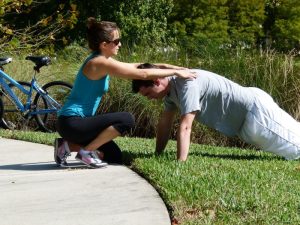
Ask the client to imagine a cup of water on their back. The goal is to keep the cup balanced by keeping the hips square to the ground and the spine straight.
Read more about proper planking in this article.
_______________________
6. Pushup
Red flag:
· Hands are wider than shoulder width
Things to try:
The client’s hands should be at shoulder-width and placed under the shoulders (not out in front or wider than the shoulders).
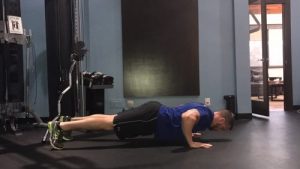
Ask the client to assume a table-top position to find the correct hand placement before moving into the push-up position. Cue the client to draw the abdominals in. If the hips begin to drop, it’s time to stop.
_________________________
5. Lat Pull
Red flag:
· Bringing the bar behind the neck
Things to try:
The client should lean slightly back to allow enough space for the bar to pass in front of the face and down to the upper chest area. Instruct the client to move the elbows down and back while keeping the chest up and out as the bar is lowered.

The bar is pulled down and toward the body (not just straight down). Pulling the bar behind the neck can create shoulder impingement.
___________________
4. Lateral Raises
Red flag:
· Keeping the palms facing the floor throughout the movement
Things to try:
Instruct the client to turn the thumbs up slightly (not so much that the head of the dumbbell is facing the ceiling).

This slight motion externally rotates the shoulders and decreases the chance of shoulder impingement. Cue the client to keep the wrists in a neutral position.
___________________
3. Plié Squat
Red flag:
· Leaning forward in the downward motion.
Things to try:
While in the plié position (toes turned slightly out rather than forward), instruct the client to pull the shoulders back and drop straight down (versus shooting the hips back and leaning forward as in a back squat).

To facilitate the initial movement, have the client stand against a wall to feel the upward and downward motion. Instruct him or her to squeeze through the inner thighs on the way up and get the hamstrings parallel in the downward motion.
_____________________
2. Shoulder Press
Red flag:
· Failing to keep the core drawn in and allowing the back to arch
Things to try:
While in either a standing or seated position, instruct the client to pull the shoulders back and draw the belly in. If balance is a concern, stagger the feet and start with a lighter weight.
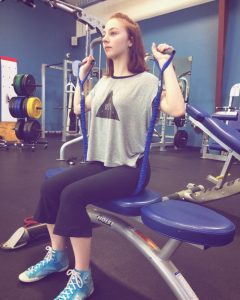
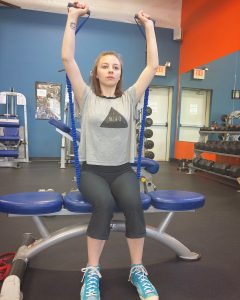
As the weight moves up and over the head, balance is further challenged and that is when the client form may suffer.
_______________________
1. Deadlift
Red flag:
· Rounding the spine
Exercise Tip:
Instruct the client to stand with feet hip-width apart and shoulders pulled back and down. The bar should remain close to the body and glide down the shins, and the spine should not round forward.

If it does, it might mean the upper back is weak and isn’t able to counteract the forward motion. Obviously, strengthening the back muscles is one fix. It could also mean the weight is just too much for the client to control effectively.
Try using a single dumbbell. The client can hold each end of the weight and practice controlling the motion down and squeezing the glutes and hamstrings on the way up.
Endless Possibilities
This list is not an exhaustive review of all possible exercise form concerns. It is also not a comprehensive list of all potential solutions to explore and test.
There are numerous ways to teach correct form and the basis for identifying solutions to common issues is a sophisticated understanding of human anatomy and kinesiology.
Take some time to build upon your existing knowledge and practice your teaching skills. Most importantly, remember that progress will never be made if the form is sacrificed.
Dr. Erin Nitschke, NFPT-CPT, NSCA-CPT, ACE Health Coach, Fitness Nutrition Specialist, Therapeutic Exercise Specialist, and Pn1 is a health and human performance college professor, fitness blogger, mother, and passionate fitness professional. She has over 15 years of experience in the fitness industry and college instruction. Erin believes in the power of a holistic approach to healthy living. She loves encouraging her clients and students to develop body harmony by teaching focused skill development and lifestyle balance. Erin is also the Director of Educational Partnerships & Programs for the NFPT. Erin is an editorial author for ACE, IDEA, The Sheridan Press, and the Casper Star Tribune. Visit her personal blog at belivestaywell.com

